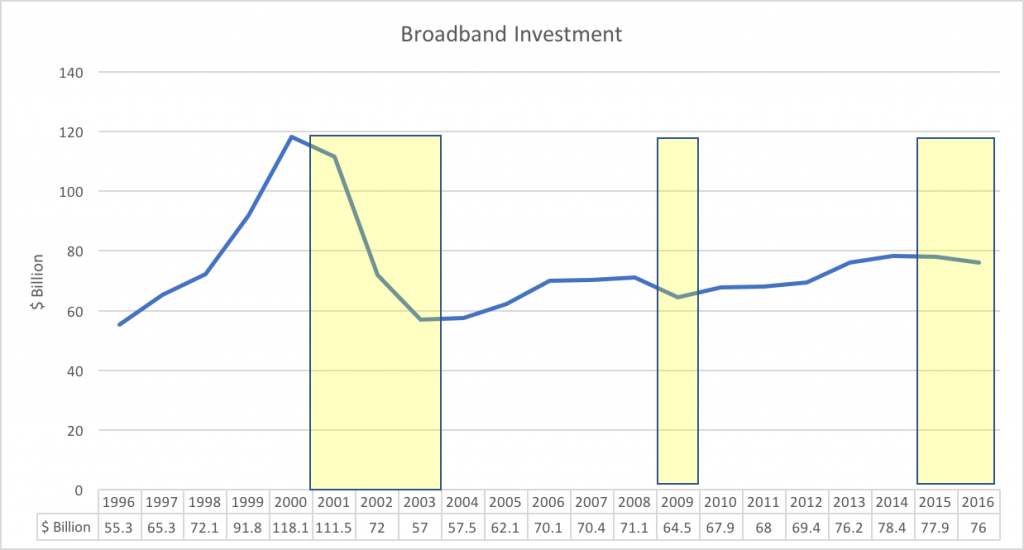Depressing Investment Figures
Figures released by US Telecom on Tuesday showed reduced spending on broadband infrastructure for the second year in a row. While 2014 was the best year for broadband investment since the fiber bubble of 1999-2001, the decline that began in 2015 has continued. This is the only non-recession decline in broadband investment the the US has ever seen.
This is also only the second time in US broadband history that an investment decline has lasted more than a year. The collapse of the fiber bubble is still the most catastrophic event, and the one-year decline in 2009 was worse than the present drop. It could be worse.
Why the Investment Pullback?
We obviously can’t infer causes from a two year data series, so there will be debate about the reasons for this drop in investor confidence. Looking backward, we can find some explanations.
The collapse of the fiber bubble was mainly a reaction to general economic conditions, but it was also driven by the realization that irrational exuberance over fiber networks was premature. While the fiber bubble was partly the anticipation of Internet apps such as Pets.com, much more of it was speculation on the deregulated telephone network. But it turned out that telephone service was going to swallowed-up by the cellular network and the Internet.
Fiber empresarios and network visionaries had touted the immense power of fiber optics since the 1960s, when David Sarnoff gave moving speeches about the future of telecommunications. Sarnoff was followed by people like the stock market tout George Gilder and latter-day fiber progressives such as Susan Crawford.
Investment Can be Misguided
But these forecasters failed to appreciate the limited power to networks to reshape consumer behavior. And even more significantly, they failed to realize the potential of less-costly alternatives to fiber such as wireless and the cable TV network.
Cable has continued to advance thanks to innovations such as full-duplex, baseband DOCSIS 3.1. This development will ultimately raise the data rate of residential connections to 10 Gbps, and it’s backed up by fiber. 5G wireless will also touch tens of gigabits per second as well, and it’s also backed up by fiber. And 5G is mobile, a very big plus.
If speculators in the late 1990s had understood that fiber was simply a backhaul technology, the excessive investment might well have been better directed. About $160B was over-invested in networks from 1998-2002, enough to make a big impact on chips, devices, and applications. But it’s hard to predict technology.
The Current Decline is Concerning
It’s hard for the broadband companies to know where and how to invest their infrastructure spending. DOCSIS 3.1 gives the cable companies a powerful weapon, but consumers often want conveniences such as mobility more than speed. 5G seems like a sure bet, but the costs of deploying the new infrastructure are highly dependent on access to publicly-owned facilities that aren’t always priced appropriately.
It’s reasonable to expect that broadband investment will increase at rates that reflect both population increases and economic growth, and that’s not happening. It’s also reasonable to expect the web to at least keep up with broadband in terms of performance, but that hasn’t happened for more than a decade.
While web speed is stagnant across the board, the networks run by the Big Five are improving at a rapid rate. This is what we should expect for the simple reason that the web’s mega-giants have both the cash and the incentives to invest in faster networks and data centers of their own. The smaller web sites are the ones on pain.
Policy Matters
If history is any guide, US web policy – mainly Section 230 – promotes the formation of monopolies. Monopolies build motes against competition and manipulate regulators to maintain the status quo. But the mega-giants of the web have done some innovation as well, even it it has more to do with advertising than anything else.
Broadband policy could benefit from a dose of stability while the next generation networks are under construction. Whatever you think about Title II and zero rating (many like the first and hate the second), it’s hard to justify endless oscillation between Title I and Title II. Broadband networks are long-term investments so the unprecedented investment drop probably signals uncertainty.
This is basic engineering financial sense: if you don’t know what market and regulatory conditions are going to look like over the next five to ten years, it’s prudent to rein in construction and focus on research. Research, at least, will enable your company to capitalize on whatever opportunities do arise in the brief respites between regulatory battles.
So we’re seeing more thinking and less doing in broadband networks. A clear, fair, and stable policy detente will help, but it’s also necessary to do something about the web monopolies who rule an increasingly stagnant marketplace.




